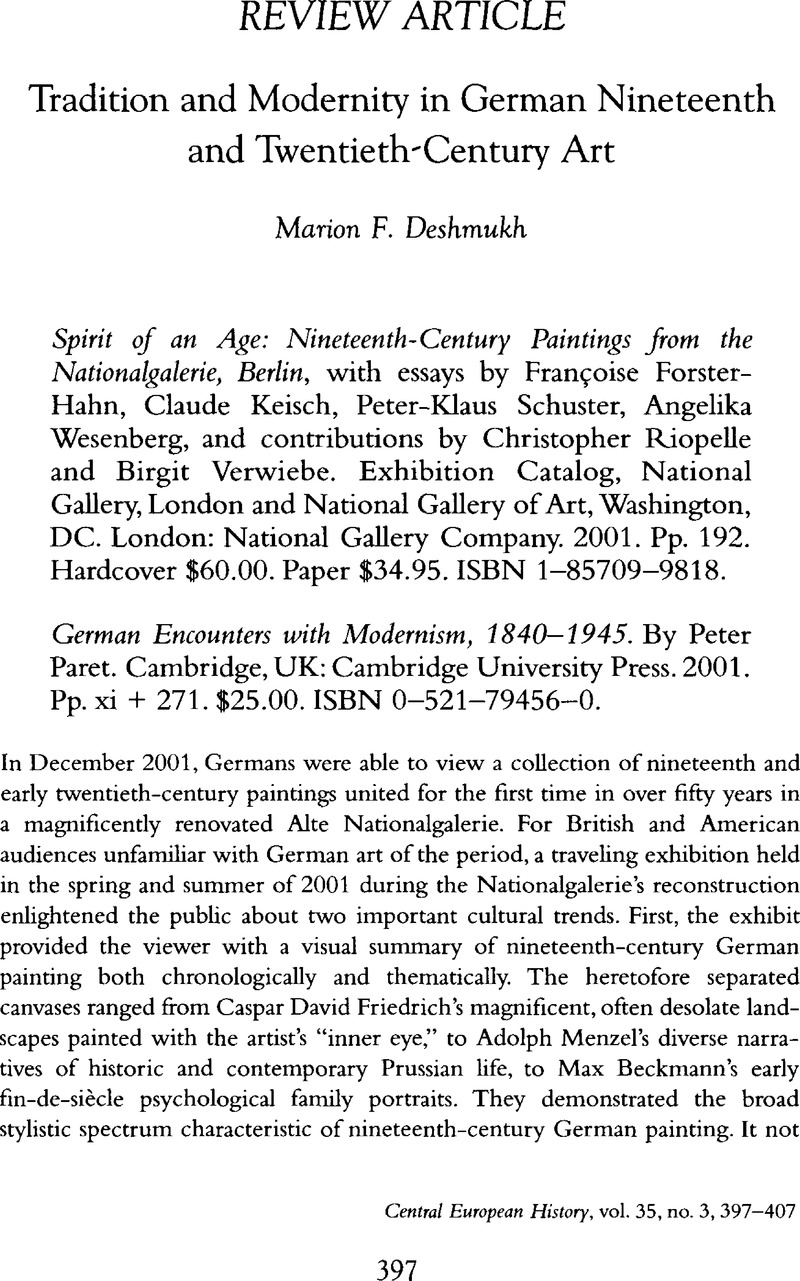No CrossRef data available.
Article contents
Tradition and Modernity in German Nineteenth and Twentieth-Century Art
Published online by Cambridge University Press: 16 December 2008
Abstract

- Type
- Review Article
- Information
- Copyright
- Copyright © Conference Group for Central European History of the American Historical Association 2002
References
1. Several major museum exhibitions held in England and the United States have drawn attention to the German contribution to nineteenth-century modernism, including: Metropolitan Museum of Art, Exhibition Catalog, German Masters of the Nineteenth Century, Paintings ana Drawings from the Federal Republic (New York, 1981)Google Scholar; High Museum of Art, Exhibition Catalog, Art in Berlin, 1815–1989 (Atlanta, 1989)Google Scholar; National Gallery of Art, Exhibition Catalog, Adolph Menzel, 1815–1905: Between Romanticism and Impressionism (Washington, DC, 1996–1997)Google Scholar; St. Louis Museum of Art and Tate Gallery, London, Exhibition Catalog, Lovis Corinth (St. Louis & London, 1996–1997)Google Scholar; The Jewish Museum, New York, Exhibition Catalog, Berlin Metropolis:Jews and the New Culture, 1890–1918 (Berkeley, 1999)Google Scholar; Leipzig Museum of Fine Arts & Museum of Fine Arts, Houston, Exhibition Catalog, Romantics, Realists and Revolutionaries: Masterpieces of Nineteenth Century German Paintings from the Museum of Fine Arts (Leipzig, 2000)Google Scholar; selected English language monographs and volumes include: Robert Rosenblum's early reexamination of German Romanticism in his Modern Painting and the Northern Romantic Tradition, Friedrich to Rothko (London, 1975)Google Scholar; Lenman, Robin, Artists and Society in Germany, 1850–1914 (Manchester, 1997)Google Scholar; Paret, Peter, Art as History: Episodes in the Culture and Politics of Nineteenth-Century Germany (Princeton, 1988)Google Scholar; Paret, Peter, The Berlin Secession: Modernism and its Enemies in Imperial Germany (Cambridge, Mass., 1980)CrossRefGoogle Scholar; Makela, Maria, The Munich Secession: Art and Aesthetics in Turn-of-the-Century Munich (Princeton, 1990)Google Scholar; Forster-Hahn, Françoise, ed., Imagining Modern German Culture, 1889–1910 (Washington, DC, 1996)Google Scholar; Sheehan, James J., Museums in the German An World: From the End of the Old Regime to the Rise of Modernism (New York, 2000)Google Scholar. Robert Jensen takes an important comparative view in his Marketing Modernism in Fin-de-Siècle Europe (Princeton, 1994)Google Scholar. A recent survey text taking the story through to the 1930s is West's, ShearerThe Visual Arts in Germany, 1890–1937: Utopia and Despair (New Brunswick, 2000)Google Scholar. Belting, Hans, The Germans and Their Art: A Troublesome Relationship (New Haven, 1998)Google Scholar, recently critiqued Germany's historic and contemporary acceptance or rejection of modernism in an extended essay. See Paret's, Peter review of Belting's volume in, “Three Perspectives on Art as a Force in German History,” Central European History 34, no. 1 (2001): 83–89.CrossRefGoogle Scholar
2. Harvard University's Busch-Reisinger's Museum, dedicated to German art, was an exception to this trend. On the promotion of German art in the U.S. during the early twentieth century, see: Bealle, Penny Joy, “Obstacles and Advocates: Factors influencing the introduction of modern art from Germany to New York City, 1912–33: Major promoters and exhibitions,” (Ph.D. diss., Cornell University, 1990).Google Scholar
3. Los Angeles County Museum of Art, The Art Institute of Chicago, Smithonian Institution International Gallery, Exhibition Catalog, “Degenerate Art”: The Fate of the Avant-Garde in Nazi Germany (Los Angeles, 1991)Google Scholar; Los Angeles County Museum of Art, Montreal Museum of Fine Arts, Neue Nationalgalerie, Berlin, Exhibition Catalog, Exiles and Emigrés: The Flight of European Artists from Hitler (Los Angeles, 1997).Google Scholar
4. This cultural reality is well described by Forster-Hahn, in the catalog essay, “Art without a Center: German Painting in the Nineteenth Century,” 19–39.Google Scholar
5. Cf. Deshmukh, Marion, “Recovering Culture: Berlin's National Gallery and the U.S. Occupation, 1945–1949,” Central European History 27, no. 4 (1994): 411–39Google Scholar, translated and published in a revised version as “Die Wiederherstellung der Kultur: Die Nationalgalerie und die amerikanische Besatzung (1945–1949), in “Der deutschen Kunst”: Nationalgalerie und nationale Identität, ed. Ruckert, Claudia & Kuhrau, Sven (Leipzig, 1998).Google Scholar
6. The exhibited paintings include: Courbet's, GustaveThe Source of the Lison (1864)Google Scholar; two works by Monet, Claude: St. Germain-l'Auxerrois (1867)Google Scholar and Summer (1874)Google Scholar; Manet's, EdouardVilla at Rueil (1882)Google Scholar, and Cézanne's, PaulMill on the Couleuvre at Pontoise (1881)Google Scholar. Except for the Courbet painring, donated to the museum in 1969, the others were donated during the directorship of Tschudi at the turn of the century.
7. A small museum dedicated to late nineteenth and twentieth century German and Austrian art recently opened in New York City, the Neue Galerie. Its opening may increase the visibility of fin-de-siècle Central European art. See their catalogue, published for the museum's opening exhibition: New Worlds, German and Austrian Art, 1890–1940 (New York, 2001).Google Scholar
8. Cf. note 1.
9. Ibid.
10. See the exhibition catalog essays in Adolph Menzel, 1815–1905: Between Romanticism and Impressionism, and the numerous essays by Forster-Hahn, Françoise, cited in the Spirit of an Age catalogGoogle Scholar. Liebermann greatly admired Menzel's oeuvre.
11. By titling the Paris and Washington Menzel exhibition “Between Romanticism and impressionism,” the curators may have hoped to increase the numbers of museum visitors curious about the artist. The exhibition and lavish catalog demonstrated the true range of Menzel's oeuvre.
12. Quoted in Schuster, Peter-Klaus, “Menzel's Modernity,” in Adolph Menzel, Between Romanticism and Impressionism, 139–40.Google Scholar
13. Belting, Hans, The Germans and their Art: A Troublesome Relationship (New Haven, 1998)Google Scholar, wherein the author expressed concerns about postunification debates over the worth of former GDR art. He saw echoes of earlier acrimonious discussions, reaching back centuries and continuing through the Nazi era.
14. On the postwar careers of major Third Reich museum officials, artists, and critics, see the detailed examination by Petropoulos, Jonathan, The Faustian Bargain: The Art World in Nazi Germany (New York, 2000).Google Scholar




